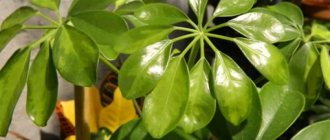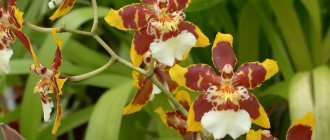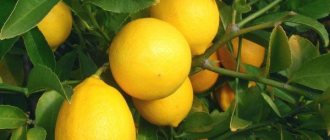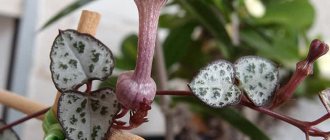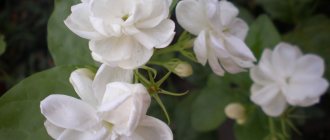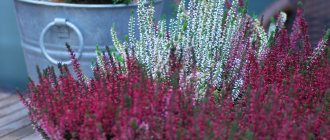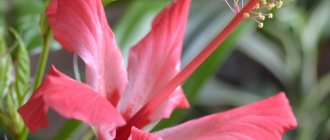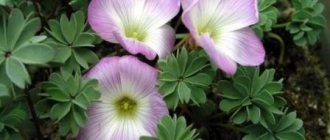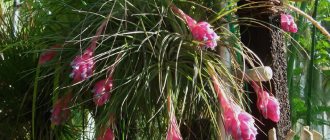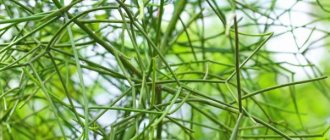Beloperone is a perennial evergreen shrub from the Acanthaceae family. Popularly known as “cancer neck” or flower shrimp.
Beloperone's homeland is South America. The plant is characterized by flexible, branched shoots ending in drooping, apical inflorescences. The flowers themselves are inconspicuous, white, and last only a few days. But the bracts that form next to them in the form of a long, loose spike last almost a year. At first they are pale and inconspicuous, then gradually acquire bright colors, from yellow to orange-red. Without pruning, the height of the plant can reach 1 meter. But small, properly formed bushes no more than 30 cm high look the most beautiful.
Be sure to check out the plant from the Acanthaceae family - Fittonia.
| Growth rate is average, up to 15 cm per year. |
| Blooms all summer. |
| The plant is easy to grow. |
| It is a perennial plant. |
Beloperone: care at home. Briefly
Beloperone at home requires certain care:
| Temperature | In summer, room temperature, in winter no less than +7°C. |
| Air humidity | Medium, if necessary, place the pot on a layer of wet expanded clay. |
| Lighting | Bright, direct light. In winter some shading is possible. |
| Watering | In summer it is plentiful, in winter no more than 2 times a month. |
| Soil for Beloperone | Highly nutritious, loose, drainage is a must. |
| Feeding and fertilizer | During the period of intensive growth, 1 time per week, with universal fertilizer. |
| Beloperone transplant | Annually, in the spring before intensive growth begins. |
| Reproduction | Stem cuttings and seeds. |
| Features of growing Beloperone | Requires constant formation. |
Planting and transplanting procedure
Among other indoor plants, Beloperone stands out for its growth rate. Therefore, young specimens will have to be replanted annually or even twice a year (in spring and late summer). For adult plants, if there is a sufficiently spacious pot, one procedure once every 2–3 years is enough. The “signal” indicating the need for replanting is roots sticking out of the drainage hole.
This plant is clearly time to be replanted.
In order not to disturb the plant too often, you can purchase a “growing” pot, with a diameter of about 10–12 cm larger than the previous one. It is better to choose a more massive ceramic container, similar to a bucket, since the above-ground part of the Beloperone is quite voluminous. The pot will balance the plant and prevent it from tipping over.
Beloperone, unlike many indoor plants, can be replanted using a “growing” pot
Beloperone is not picky about soil. An ordinary universal soil for flowering indoor plants with an acidity of 5.5–6.5 (neutral or slightly acidic) is quite suitable. Since the flower quickly grows green mass, the mixture should be light and nutritious. You can prepare the substrate yourself:
- Leaf soil, fertile turf, peat chips, humus, coarse river sand (2: 2: 1: 1: 1). Add crushed chalk or bone meal to the finished mixture (2–3% of the total volume).
- Universal soil for indoor plants, humus or rotted compost, peat chips, perlite or vermiculite (equal parts).
- Turf soil, compost, peat (1:1:2).
Beloperone is quite suitable as a universal soil for flowering indoor plants.
There is nothing complicated about the transplant itself. Even a novice florist can cope with the procedure.
- Place small expanded clay, pebbles, and other drainage material at the bottom of the new pot in a layer 3–5 cm thick. Place the substrate on top, filling about a third of the container’s volume.
- Remove the plant from the old pot. To make the task easier for yourself, water the flower generously about 20–30 minutes beforehand. Try to destroy the earthen ball as little as possible.
- Using a sharp, disinfected knife, shorten the roots by cutting off 1–1.5 cm of “fringe” at the bottom. Make several shallow longitudinal cuts on the sides and slightly “fluff” the edges.
- Move the soil ball into a new pot. Add substrate. Shake the container several times to ensure the soil is evenly distributed. Lightly press the top down with your palm.
- Water the plant moderately and remove it for 2-3 days in light partial shade. Then return it to its original place and care for it as usual.
Beloperone tends to grow, stretching unsightly and exposing the lower part of the shoots. If this happens, instead of replanting every 3–4 years, it is advisable to renew the plant by cutting cuttings from young branches and rooting them.
Gradually, the beloperone grows, stretching out unsightly; in this case, instead of replanting, you need to update the plant
Caring for beloperone at home. Details
Caring for beloperone at home has some features. This evergreen shrub tends to grow very quickly, and it also requires very careful watering.
Bloom
Beloperone begins to bloom in early spring. At the ends of the shoots it forms spike-shaped inflorescences with large bracts.
The intensity of their color depends on the level of illumination. The brighter the light, the richer the color of the bracts. The flowers themselves are two-lipped, small, white. They last only a few days on the plant. Only bracts have high decorative qualities. They form a spike more than 10 cm long. With good care and additional lighting in winter, flowering can continue throughout the year.
Temperature
The beloperone plant at home requires moderate temperatures within the range of +23-25°C. In winter, if possible, it is reduced to +13-15°C. This will prevent the shoots from stretching.
Spraying
Beloperone adapts perfectly to indoor conditions. If the air is too dry, the pot with the plant can be placed on a tray with wet gravel or expanded clay. Beloperone can also be additionally sprayed. In this case, water should not get on the inflorescences. Moisture leaves unsightly black spots on them.
For spraying, pre-filtered or settled water at room temperature is used.
Lighting
The domestic white peronese needs plenty of bright light. However, exposure to direct sunlight is undesirable. The plant feels best on windows facing southeast and southwest. On the northern side of the beloperone, additional lighting will be required in winter.
Watering beloperone
During the period of intensive growth from March to August, beloperone is watered very generously.
Since the beginning of September, the amount of watering has been reduced. In winter, the plant is watered very sparingly, no more than once every 2 weeks. Irrigation water should be soft; hard water will lead to rapid salinization and problems with the root system.
Pot for Beloperone
Plastic or ceramic pots are suitable for growing beloperone. Their volume should be slightly larger than the size of the root system. In a pot that is too large, the soil may become acidic due to intensive watering, which will lead to the development of root rot.
Priming
Beloperone is grown at home in a nutritious, loose substrate. It is made up of 2 parts turf soil, 4 parts peat and humus and 1 part river sand. At the bottom of the pot there must be drainage made of clay shards with the addition of coarse sand and charcoal.
Feeding and fertilizer
Since the end of March, beloperone has been fed weekly with complex fertilizer for indoor plants. It is diluted in strict accordance with the attached instructions. By the end of summer, feeding is stopped.
Beloperone transplant
Beloperone is replanted annually in the spring.
The plant is carefully transferred to a larger pot. Young, intensively growing specimens are replanted up to 2 times a year.
Pruning white perone
Beloperone grows very intensively, so it requires periodic pruning. It is pruned for the first time in early spring, before intensive growth. Depending on the condition, the shoots are cut by 1/3 or 2/3. To maintain shape and improve branching, repeat pruning is carried out in the summer. If desired, you can form a standard or ampel from the white perone.
To form a tree, the lower branches are gradually removed from the plant. As soon as the bush reaches the required height, the crown is plucked out. In the future, the trunk is constantly cut to maintain its shape. To form an ampel, long branches are not trimmed. When lying down, they form hanging shoots.
Rest period
Beloperone does not have a clearly defined dormant period. When the conditions are created, the plant continues to actively develop throughout the year. If the temperature is lowered, it simply reduces the growth rate.
Step-by-step instructions for reproduction
By cuttings - propagation is carried out from January to August:
- young shoots are cut into cuttings 10-15 cm
- the cut is treated with a growth solution
- cuttings are planted in a container with a sand-peat mixture, watered abundantly and covered with glass or plastic film
- after 40-50 days, the cuttings can be transplanted into a permanent pot
IMPORTANT !
Maintain the temperature at 20-25 ° and water the cuttings generously with warm water. Seeds - sowing is done in late February - early March:
- Before planting, the seeds are soaked for two days in warm water
- the container is filled with soil (leaf soil and sand – 4:1)
- the seeds are evenly distributed over the surface and covered with a small amount of substrate
- grown seedlings are transplanted into pots
Growing problems
Flower problems arise from improper care:
- overdrying or excessive soil moisture
- overfeeding with fertilizers
- insufficient lighting, especially in winter
- temperature violation
- lack of ventilation
Propagation of Beloperone by cuttings
Beloperone is easy to propagate from apical cuttings. They are cut from young, one-year-old shoots. The optimal length of the cuttings is no more than 10 cm. They must be cut directly under the bud. For rooting, mini greenhouses are prepared from cut plastic bottles.
They use a mixture of peat and perlite or sand as soil. Cuttings take root especially quickly in spring and summer. A few weeks after rooting, the young plants begin to bloom. To form dense bushes, it is advisable to pluck out the first flowers.
Features of Beloperone transplantation
Plants are replanted as the container is filled with roots, preferably replanting in the spring. Young plants may develop so rapidly that replanting will be required in the summer.
- When replanting, be careful with the root system (the roots are fragile), transfer it along with the earthen lump.
- Take the container the same size as before; if you want to use the same pot, you need to wash it thoroughly. Be sure to lay drainage at the bottom, then place a layer of moist soil mixture.
- The substrate is prepared from equal proportions of leaf soil, turf soil, humus and sand.
- The following soil mixture is suitable: two parts each of leaf, humus and turf soil, add one part each of sand and peat. It is recommended to supplement any mixture with the addition of bone meal.
Place the plant in the center of the pot with the roots down, fill the voids with the prepared substrate and firmly press the soil around the plant stem with your fingers. Keep it in the shade without watering for a couple of days after transplantation, then care for it as usual.
Diseases and pests
- The bracts turn black. When sprayed, water gets on them, resulting in dark spots.
- Beloperone leaves turn yellow. The plant suffers from flooding. It is necessary to strictly observe the irrigation regime and check for drainage.
- The plant is stretched. This is how Beloperone reacts to too high a temperature.
- Beloperone leaves turn pale. Most likely, the plant is experiencing a lack of nutrition. It is necessary to systematically apply the recommended doses of fertilizers.
- Beloperone leaves become discolored. This problem with leaves occurs with excessive watering and lack of nutrition. The earthen ball must be slightly dried, and at the next watering, complex mineral fertilizer must be added to the water.
- Rusty coloring of leaves. The problem occurs due to sunburn. The plant must be moved to a less sunny place or shaded with a light curtain.
- Beloperone leaves are falling. The problem lies in lack of moisture or draft. It is necessary to adjust the conditions of detention. For faster recovery, the plant is fed with fertilizer.
- Beloperone leaves become sticky. The plant is affected by pests. Most likely a spider mite. It is necessary to treat with special acaricide preparations. For example, you can use Actellik.
- Brown spots on leaves. Most often they are the result of flooding and excessive spraying. The earthen ball should be slightly dried and spraying should be stopped. To increase the humidity level, place a small container of water next to the pot.
Beloperone very often suffers from spider mites, whiteflies and aphids.
Pests attacking the plant
The gardener will not have to fight any exotic pests “brought” by the white perone from its historical homeland. It suffers from attacks by the most common insects and mites that feed on plant sap. In general, the flower rarely attracts their attention. Usually, to avoid infection, it is enough to follow simple preventive measures:
- quarantine newly acquired plants for 3–4 weeks;
- regularly inspect plants and immediately isolate those that exhibit suspicious symptoms;
- place indoor flowers and bouquets as far as possible from each other, preferably in different rooms;
- ventilate the room daily and increase air humidity by all available means;
- promptly cut off “bald” dried shoots and wilted buds, using not a knife or scissors, but a special pruner;
- follow the recommendations for caring for the flower, especially those related to watering and fertilizing;
- use only clean pots, disinfected soil and tools;
- Irradiate the plant with a quartz lamp weekly for 2–3 minutes.
Table: pests affecting beloperone
| Pest | Symptoms | Control measures |
| Spider mite | Thin cobwebs entwining petioles and shoots, vague pale green or yellowish spots on the underside of the leaf. |
For prevention, apply onion or garlic paste to the leaves every 2-3 weeks. After about half an hour, rinse with water. |
| Aphid | Black-brown or yellow-green insects clinging to the underside of young leaves, buds and flowers, and the tops of shoots. |
|
| Whitefly | Small whitish butterflies that resemble moths. They rise into the air as soon as you touch the flower. |
|
| Mealybug | Whitish lumps, similar to cotton wool or poplar fluff, in the axils of the leaves, at the base of the shoots, a thin continuous layer of plaque of the same color on the underside of the leaf. |
For prevention, once a week, spot-apply preparations based on Neem tree oil to the leaves. |
| Shchitovka | Gray-brown growths on leaves and shoots, gradually increasing in volume. The surrounding tissues turn yellow or red, and the substrate in the pot becomes unnaturally black. |
For prevention, spray the plants with an infusion of hot pepper or tobacco crumbs once a week. |
Photo gallery: what pests that attack a flower look like
Spider mites are not insects, so general insecticides are useless; special preparations are used - acaricides
Aphids are one of the most “omnivorous” insects that infect indoor plants; beloperone is also included in its sphere of attention.
For some reason, the whitefly is partial to the color yellow; this feature is used in the manufacture of homemade traps from cardboard smeared with something sticky
Mealybugs seem fairly harmless, but they can easily kill a plant if left untreated.
The scale insect is reliably protected by a durable shell, so the use of folk remedies will not give the expected effect
Types of home white peronese with photos and names
The following types are used in indoor floriculture:
Beloperone drip (Beloperone guttata)
Without formation, it grows about a meter high. The shoots are well branched, flexible, and partially lignified at the base. Drooping inflorescences are formed at the tops of branches. The leaves are deep green, medium-sized, with slight pubescence. The bracts are yellowish-pink. The intensity of their color depends on the brightness of the lighting. Two varieties of drip beloperone are well known among flower growers: “Lutea” and “Yellow Queen” with rich yellow bracts.
Beloperone plumbaginifolia
Quite a rare species. It is a subshrub up to 1.5 meters high. Shoots are straight, slightly branched. The leaves are lanceolate-shaped, with a smooth surface, and intensely green in color. The bracts are bright red.
Botanical description
Beloperone is a perennial evergreen plant of the Acanthus family, growing in the form of a shrub or subshrub.
What does a beloperone flower look like? The stems are erect and branched, they are slightly woody, especially at the base. The leaf blades are oblong, have pointed tops and carved edges. The surface of the leaf is leathery, shiny, rich green in color, the veins are clearly visible. The leaves may be slightly pubescent on the reverse side. The official name of the plant is formed by combining two words “belos” and “perone”, which literally means “arrowhead” in Greek. This name was inspired by the inflorescences of Beloperone, which appear in the axils of the leaves.
When does Beloperone bloom?
“Shrimp inflorescences” decorate beloperone almost all year round. The spike-shaped inflorescences are similar to hop cones, but in Beloperone they are longer, however, the flower is often called indoor hop. The colors are in bright colors: yellow, red, orange, due to which many note the similarity of the inflorescences with the tail of shrimp. There was no consensus among scientists regarding the separation of Beloperone into a separate genus; initially the plant was classified as a member of the genus Justice.
According to various sources, the genus Beloperone has 30-60 plant species. In the natural environment, they are common in the tropics and subtropics of America.
